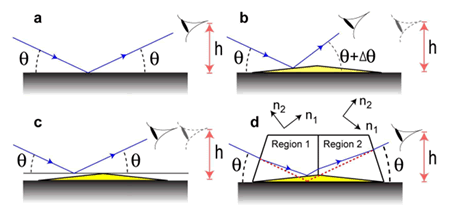Science Fiction
Dictionary
A B C D E F G H I J K L M N O P Q R S T U V W X Y Z
Invisibility Cloak Fools Naked Eye

An invisibility cloak that hides objects visible to the naked eye has been created by MIT researchers. Baile Zhang and colleagues have created an invisibility cloak capable of hiding objects in the millimeter range over a broad range of visible frequencies from red to blue.
Even better, this feat is accomplished using naturally-occurring materials shaped by conventional optical lens fabrication techniques. DIY invisibility cloaks, anyone?

(Cloaking device works the angles)
(a) A light ray is incident on a flat ground plane and reflected back with the same angle.
(b) When an object is sitting on the ground plane, the reflected ray changes its angle.
(c) When another flat ground plane is put on top of the object, the reflected ray restores its angle but suffers a lateral shift.
(d) When a transformation-based anisotropic cloak is covering the object, the reflected ray restores both its angle and position. The anisotropic medium has two principal refractive indexes n1 and n2 along two orthogonal directions. The observer in all cases is assumed to have a fixed height of h. In b and c, the original position of the observer is indicated with a dotted eye.
In the abstract to their paper , Zhang describes their work:
Invisibility cloaks, a subject that usually occurs in science fiction and myths, have attracted wide interest recently because of their possible realization. The biggest challenge to true invisibility is known to be the cloaking of a macroscopic object in the broad range of wavelengths visible to the human eye. Here we experimentally solve this problem by incorporating the principle of transformation optics into a conventional optical lens fabrication with low-cost materials and simple manufacturing techniques. A transparent cloak made of two pieces of calcite is created. This cloak is able to conceal a macroscopic object with a maximum height of 2 mm, larger than 3500 free-space-wavelength, inside a transparent liquid environment.
'Doc' Smith discussed the same idea in his famed 1934 novel Triplanetary:
"This structure, floating in a planetary orbit, was designed by me and built under my direction. It is protected from meteorites by certain forces of my devising. It is undetectable and invisible--your detectors do not touch it and light-waves are bent around it without loss or distortion. I am discussing these points at such length so that you may realize exactly your position. As I have intimated, you can be of assistance to me if you will."
(Read more about 'Doc' Smith's invisibility shield)
Macroscopic Invisible Cloak for Visible Light (pdf) via Technology Review.
Scroll down for more stories in the same category. (Story submitted 12/15/2010)
Follow this kind of news @Technovelgy.| Email | RSS | Blog It | Stumble | del.icio.us | Digg | Reddit |
Would
you like to contribute a story tip?
It's easy:
Get the URL of the story, and the related sf author, and add
it here.
Comment/Join discussion ( 3 )
Related News Stories - (" Engineering ")
Tornyol Microdrone Kills Mosquitoes
'The real border was defended by... a swarm of quasi-independent aerostats.'
PLATO Spacecraft, Hunter Of Habitable Planets, Now Ready
'I ... set my automatic astronomical instruments to searching for a habitable planet.' Edmond Hamilton (1936).
Did The Yautja Have These First?
What a marvel of ingenuity the little device was! - Harry Bates, 1934.
Jetson ONE Air Races Begin, Can Air Polo Be Far Behind?
'If you're one of those rarities who haven't attended a rocket-polo "carnage", let me tell you it's a colorful affair.' - John Victor Peterson, 1938.
Technovelgy (that's tech-novel-gee!) is devoted to the creative science inventions and ideas of sf authors. Look for the Invention Category that interests you, the Glossary, the Invention Timeline, or see what's New.
Science Fiction
Timeline
1600-1899
1900-1939
1940's 1950's
1960's 1970's
1980's 1990's
2000's 2010's
Current News
Proof Of Robothood - Not A Person
'Who are you people? - Show 'em.'
Dancing Robots Taught Dance Moves
'A clockwork figure would be the thing for you...'
Indonesian Clans Battle
'The observation vehicle was of that peculiar variety used in conveying a large number of people across rough terrain.'
The 'Last Mile' In China Crowded With Delivery Robots
Yes, it's a delivery robot. On wheels.
Tornyol Microdrone Kills Mosquitoes
'The real border was defended by... a swarm of quasi-independent aerostats.'
PLATO Spacecraft, Hunter Of Habitable Planets, Now Ready
'I ... set my automatic astronomical instruments to searching for a habitable planet.'
Factory Humanoid Robots Built By Humanoid Robots
'...haven't you a section of the factory where only robot labor is employed?'
iPhone Air Fulfils Jobs' Promise From 2007 - A Giant Screen!
'... oblongs were all over the floor and surfaces.'
ChatGPT Now Participates in Group Chats
'...the city was their laboratory in human psychology.'
iPhone Pocket All Sold Out!
'A long, strong, slender net...'
Did The Yautja Have These First?
What a marvel of ingenuity the little device was!
Jetson ONE Air Races Begin, Can Air Polo Be Far Behind?
'If you're one of those rarities who haven't attended a rocket-polo "carnage", let me tell you it's a colorful affair.'
Will Space Stations Have Large Interior Spaces Again?
'They filed clumsily into the battleroom, like children in a swimming pool for the first time, clinging to the handholds along the side.'
Mornine Sales Robot
'Robot-salesmen were everywhere, gesturing...'
Bipedal Robot Floats Gently While Walking
'a walking balloon proceeded with long strides of its aluminum legs...'
Musk Idea Of Cars Talking To Each Other Predicted 70 Years Ago
'My cars talk to one another.'
